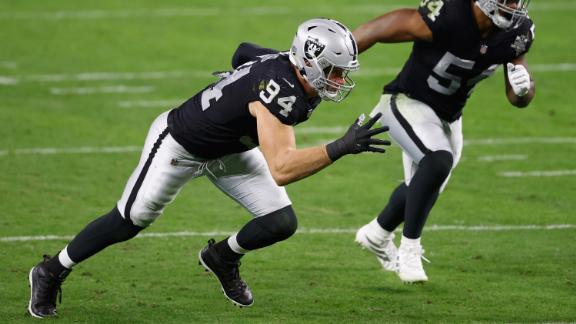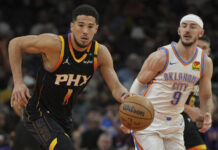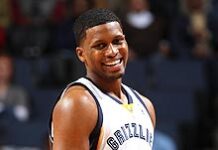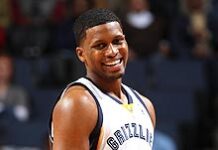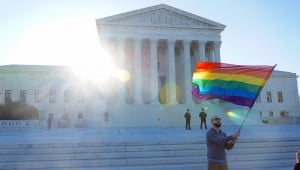Carl Nassib’s coming out was casual, matter-of-fact and, evidenced by the ebullient smile he wore throughout the video in which he disclosed his sexuality, a release he’d long waited for.
The laid-back nature of his announcement belies how exceedingly rare it was for Nassib to come out at all.
The Las Vegas Raiders defensive end is now just one of two openly gay active players in the history of the four biggest North American sports leagues (the National Football League, National Basketball Association, Major League Baseball and the National Hockey League). He joins Jason Collins, an NBA veteran who came out in 2013 and retired after the following season.
Those leagues have, combined, had nearly four centuries between them and tens of thousands of players. And of all the men who’ve ever swung a bat, smacked a puck, dodged a tackler or sunk a basket, only a handful have ever come out, typically after they’ve retired.
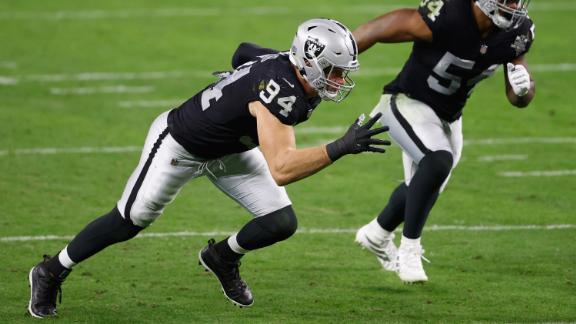
It’s not that gay men aren’t playing professional sports, experts say. But narrow perceptions of male athletes and what it means to be masculine still dominate men’s and boys’ sports, which likely keeps them from coming out.
Nassib is a 6-foot-7 defender with quick feet who competes in one of the world’s most aggressive sports. He’s also an amateur financial literacy instructor who loves Taylor Swift. There’s no precedent for what he’s done – coming out while he’s still in the NFL – and he’s laying the path for players behind him to follow.
The swell of support so far for Nassib might just cause the professional sports world to examine its culture more closely, said Wade Davis, a retired player who trained with some NFL teams during preseasons before coming out in retirement.
“I think that we have to get to a space where athletes, where men in general and where parents, mentors, teachers … start to stretch and force and crack the idea of masculinity open,” Davis told CNN. “Sports leagues have an opportunity and a responsibility to continue to widen our definitions of manhood, knowing that the more that they create spaces for people to be more themselves, the better player they’ll actually be.”
Homophobic language is still part of youth sports culture
The reason why there aren’t more Carl Nassibs isn’t entirely the fault of professional sports – the problems begin on youth teams, said Erik Denison, a behavioral scientist and lead researcher on the Sport Inclusion Project at Monash University in Australia.
Homophobic language is still a regular feature of playing on a boys’ sports team in the US and abroad, Denison’s research shows – one of his studies found that more than half of the ice hockey and rugby players he interviewed said they’d used slurs. Regular exposure to slurs or stereotypes eventually reinforces among players that their success as an athlete is tied to an idea of masculinity that excludes gay men, he said.
Denison described what he calls a “cycle of exclusion” that begins when a boy hears coaches or older players use homophobic language and observes a “positive response” to that behavior – maybe they laugh at each other, or the coach doesn’t challenge them, he said.
That sends the message that homophobic language is harmless and OK to use – and cements the assumption that all members of the team are heterosexual.
Gay players on those teams may also use the language as a shield to hide their sexuality and conform with their team, Denison said. In many cases, though, gay players will just drop out of the sport. And when the language goes unchecked, the cycle continues – all the way up to professional leagues.
“To solve this problem, it needs to start with the coaches, in particular, challenging language and, most importantly, not using that language or behavior themselves,” Denison said. “We often find that male coaches continue to use homophobic language and teach conformity to this tough masculine athlete identity that doesn’t really exist,” he said.
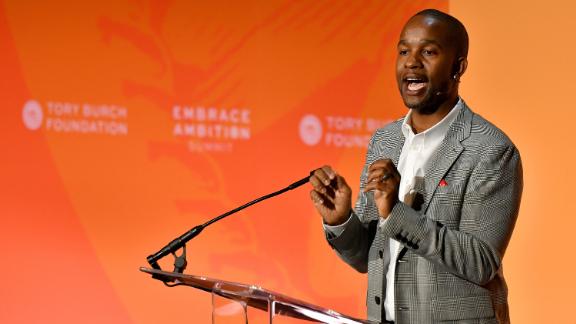
Davis, who spent some preseasons with NFL teams like the Tennessee Titans and Seattle Seahawks until an injury forced him to retire, came out nine years after he left the game – largely because he didn’t want to alienate his teammates.
“It wasn’t the NFL, it wasn’t college, it wasn’t high school that caused me to hide my sexual orientation,” he told CNN. “It was what I learned as a young kid.”
As a child, before Davis understood what it meant to be LGBTQ, he was already absorbing the norms being set around him during practice – that “being gay in those walls was unsafe, that [he] would be in danger.”
In high school, he tried to “comport his boyishness” in such a way so that his teammates wouldn’t consider him effeminate. And by the time he was in an NFL locker room, he said he didn’t hear homophobic slurs being used, but sexist ones.

